gas type INFINITI Q50 2019 Owners Manual
[x] Cancel search | Manufacturer: INFINITI, Model Year: 2019, Model line: Q50, Model: INFINITI Q50 2019Pages: 468, PDF Size: 2.15 MB
Page 170 of 468

3-26Pre-driving checks and adjustments
that people become locked inside the trunk
or in the event of the loss of electrical power
such as a discharged battery.
Releasing inside the trunk
To open the trunk lid from the inside, pull the
release handleuntil the lock releases and
push up on the trunk lid. The release lever is
made of a material that glows in the dark
after a brief exposure to ambient light.
The handle is located on the back of the
trunk lid as illustrated.
Releasing from the rear seat
You can access the release handle through
the trunk pass-through (rear seat armrest).
(See “Armrest” (P.1-7).)
To open the trunk lid from the rear seat, pull
the release handle towards front of vehicle
until the lock releases.
If you cannot reach the release handle,
contact an INFINITI retailer.SPA2735
OPENING THE FUEL-FILLER
DOOR
To open the fuel-filler door, unlock the fuel-
filler door by using one of the following
operations, then push the upper left side of
the door.
. Touch the one touch unlock sensor on
one of the front door handles and then
push the door handle request switch
while carrying the Intelligent Key.
. Push the UNLOCK button on the Intel-
ligent Key twice.
. Insert the mechanical key into the door
lock cylinder and turn it to the rear of the
vehicle twice. .
Push the power door lock switch to the
UNLOCK position.
To lock, close the fuel-filler door securely
and lock all doors by operating the door
handle request switch, the LOCK button on
the Intelligent Key, the mechanical key or the
power door lock switch.
FUEL-FILLER CAP
WARNING
. Gasoline is extremely flammable and
highly explosive under certain condi-
tions. You could be burned or ser-
iously injured if it is misused or
mishandled. Always stop engine and
do not smoke or allow open flames or
sparks near the vehicle when refuel-
ing.
. Do not attempt to top off the fuel
tank after the fuel pump nozzle shuts
off automatically. Continued refuel-
ing may cause fuel overflow, resulting
in fuel spray and possibly a fire.
. Use only an original equipment type
fuel-filler cap as a replacement. It has
a built-in safety valve needed for
proper operation of the fuel system
and emission control system. An in-
correct cap can result in a serious
FUEL-FILLER DOOR
Page 326 of 468
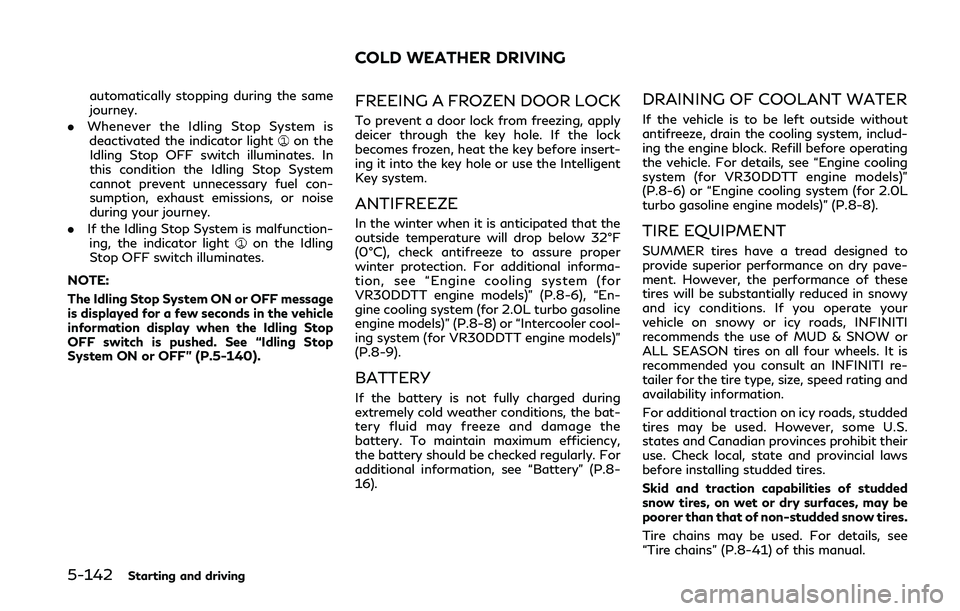
5-142Starting and driving
automatically stopping during the same
journey.
. Whenever the Idling Stop System is
deactivated the indicator light
on the
Idling Stop OFF switch illuminates. In
this condition the Idling Stop System
cannot prevent unnecessary fuel con-
sumption, exhaust emissions, or noise
during your journey.
. If the Idling Stop System is malfunction-
ing, the indicator light
on the Idling
Stop OFF switch illuminates.
NOTE:
The Idling Stop System ON or OFF message
is displayed for a few seconds in the vehicle
information display when the Idling Stop
OFF switch is pushed. See “Idling Stop
System ON or OFF” (P.5-140).
FREEING A FROZEN DOOR LOCK
To prevent a door lock from freezing, apply
deicer through the key hole. If the lock
becomes frozen, heat the key before insert-
ing it into the key hole or use the Intelligent
Key system.
ANTIFREEZE
In the winter when it is anticipated that the
outside temperature will drop below 32°F
(0°C), check antifreeze to assure proper
winter protection. For additional informa-
tion, see “Engine cooling system (for
VR30DDTT engine models)” (P.8-6), “En-
gine cooling system (for 2.0L turbo gasoline
engine models)” (P.8-8) or “Intercooler cool-
ing system (for VR30DDTT engine models)”
(P.8-9).
BATTERY
If the battery is not fully charged during
extremely cold weather conditions, the bat-
tery fluid may freeze and damage the
battery. To maintain maximum efficiency,
the battery should be checked regularly. For
additional information, see “Battery” (P.8-
16).
DRAINING OF COOLANT WATER
If the vehicle is to be left outside without
antifreeze, drain the cooling system, includ-
ing the engine block. Refill before operating
the vehicle. For details, see “Engine cooling
system (for VR30DDTT engine models)”
(P.8-6) or “Engine cooling system (for 2.0L
turbo gasoline engine models)” (P.8-8).
TIRE EQUIPMENT
SUMMER tires have a tread designed to
provide superior performance on dry pave-
ment. However, the performance of these
tires will be substantially reduced in snowy
and icy conditions. If you operate your
vehicle on snowy or icy roads, INFINITI
recommends the use of MUD & SNOW or
ALL SEASON tires on all four wheels. It is
recommended you consult an INFINITI re-
tailer for the tire type, size, speed rating and
availability information.
For additional traction on icy roads, studded
tires may be used. However, some U.S.
states and Canadian provinces prohibit their
use. Check local, state and provincial laws
before installing studded tires.
Skid and traction capabilities of studded
snow tires, on wet or dry surfaces, may be
poorer than that of non-studded snow tires.
Tire chains may be used. For details, see
“Tire chains” (P.8-41) of this manual.
COLD WEATHER DRIVING
Page 339 of 468
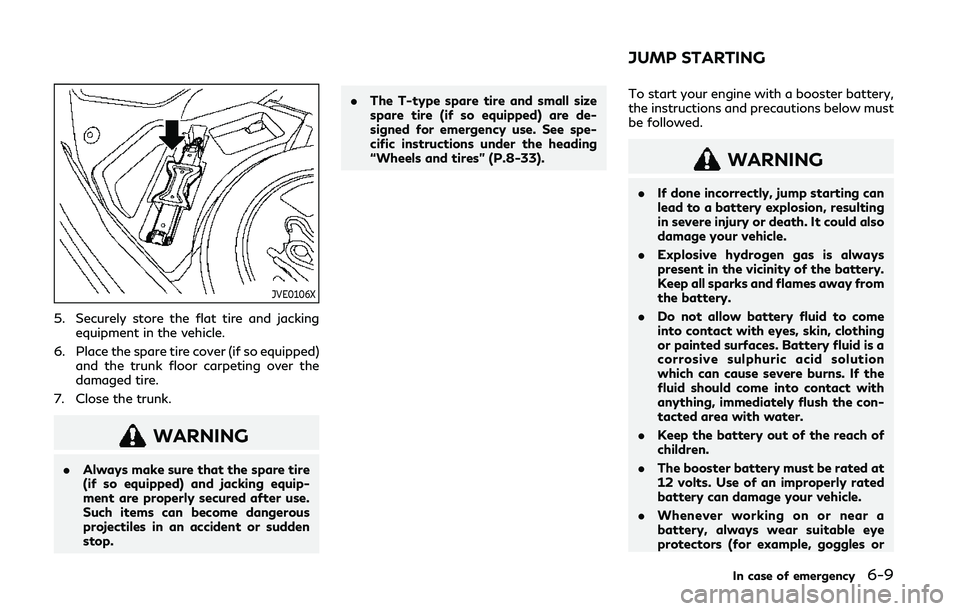
JVE0106X
5. Securely store the flat tire and jackingequipment in the vehicle.
6. Place the spare tire cover (if so equipped) and the trunk floor carpeting over the
damaged tire.
7. Close the trunk.
WARNING
. Always make sure that the spare tire
(if so equipped) and jacking equip-
ment are properly secured after use.
Such items can become dangerous
projectiles in an accident or sudden
stop. .
The T-type spare tire and small size
spare tire (if so equipped) are de-
signed for emergency use. See spe-
cific instructions under the heading
“Wheels and tires” (P.8-33). To start your engine with a booster battery,
the instructions and precautions below must
be followed.
WARNING
.
If done incorrectly, jump starting can
lead to a battery explosion, resulting
in severe injury or death. It could also
damage your vehicle.
. Explosive hydrogen gas is always
present in the vicinity of the battery.
Keep all sparks and flames away from
the battery.
. Do not allow battery fluid to come
into contact with eyes, skin, clothing
or painted surfaces. Battery fluid is a
corrosive sulphuric acid solution
which can cause severe burns. If the
fluid should come into contact with
anything, immediately flush the con-
tacted area with water.
. Keep the battery out of the reach of
children.
. The booster battery must be rated at
12 volts. Use of an improperly rated
battery can damage your vehicle.
. Whenever working on or near a
battery, always wear suitable eye
protectors (for example, goggles or
In case of emergency6-9
JUMP STARTING
Page 366 of 468
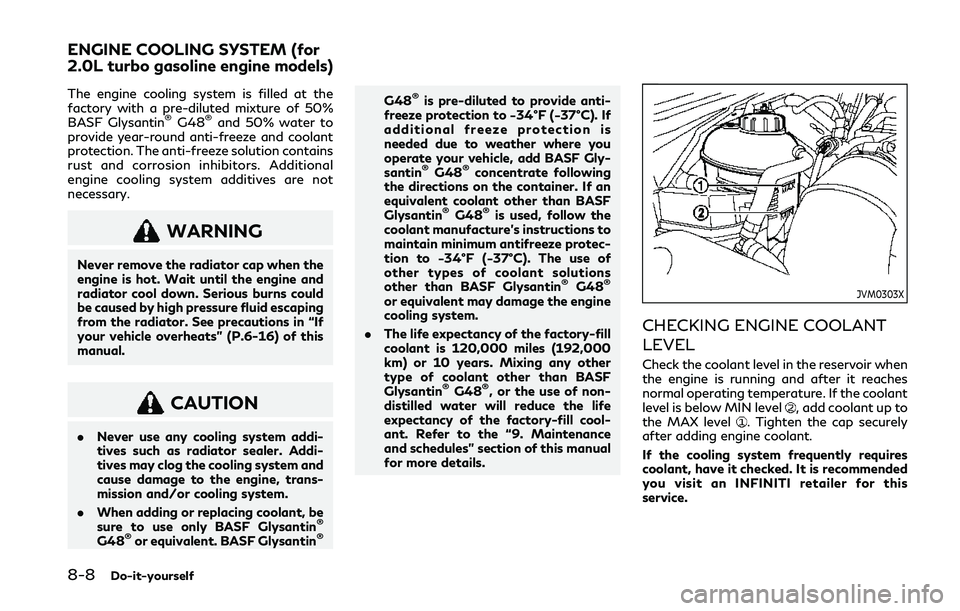
8-8Do-it-yourself
The engine cooling system is filled at the
factory with a pre-diluted mixture of 50%
BASF Glysantin
®G48®and 50% water to
provide year-round anti-freeze and coolant
protection. The anti-freeze solution contains
rust and corrosion inhibitors. Additional
engine cooling system additives are not
necessary.
WARNING
Never remove the radiator cap when the
engine is hot. Wait until the engine and
radiator cool down. Serious burns could
be caused by high pressure fluid escaping
from the radiator. See precautions in “If
your vehicle overheats” (P.6-16) of this
manual.
CAUTION
. Never use any cooling system addi-
tives such as radiator sealer. Addi-
tives may clog the cooling system and
cause damage to the engine, trans-
mission and/or cooling system.
. When adding or replacing coolant, be
sure to use only BASF Glysantin
®
G48®or equivalent. BASF Glysantin®
G48®is pre-diluted to provide anti-
freeze protection to −34°F (−37°C). If
additional freeze protection is
needed due to weather where you
operate your vehicle, add BASF Gly-
santin
®G48®concentrate following
the directions on the container. If an
equivalent coolant other than BASF
Glysantin
®G48®is used, follow the
coolant manufacture’s instructions to
maintain minimum antifreeze protec-
tion to −34°F (−37°C). The use of
other types of coolant solutions
other than BASF Glysantin
®G48®
or equivalent may damage the engine
cooling system.
. The life expectancy of the factory-fill
coolant is 120,000 miles (192,000
km) or 10 years. Mixing any other
type of coolant other than BASF
Glysantin
®G48®, or the use of non-
distilled water will reduce the life
expectancy of the factory-fill cool-
ant. Refer to the “9. Maintenance
and schedules” section of this manual
for more details.
JVM0303X
CHECKING ENGINE COOLANT
LEVEL
Check the coolant level in the reservoir when
the engine is running and after it reaches
normal operating temperature. If the coolant
level is below MIN level
, add coolant up to
the MAX level. Tighten the cap securely
after adding engine coolant.
If the cooling system frequently requires
coolant, have it checked. It is recommended
you visit an INFINITI retailer for this
service.
ENGINE COOLING SYSTEM (for
2.0L turbo gasoline engine models)
Page 409 of 468
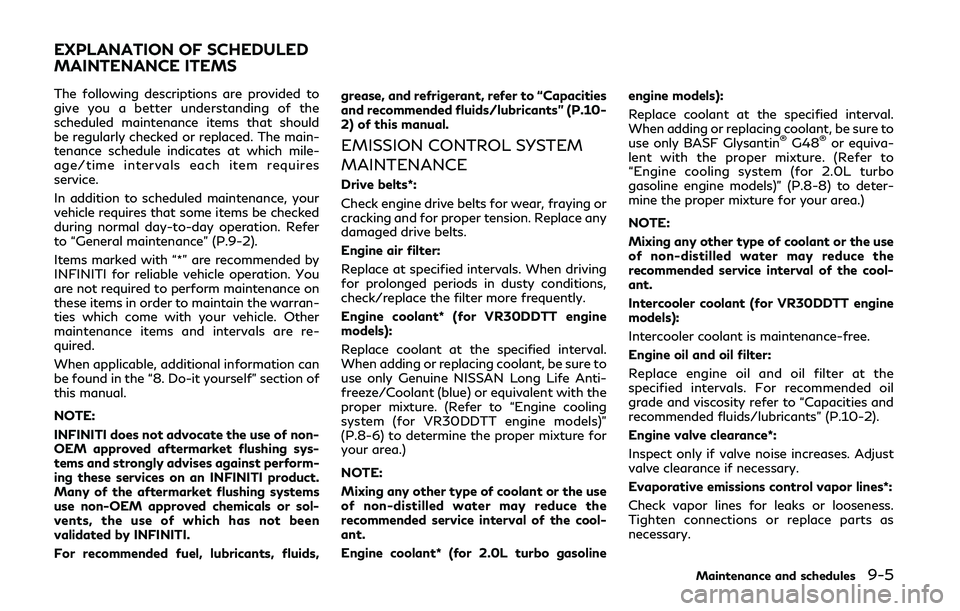
The following descriptions are provided to
give you a better understanding of the
scheduled maintenance items that should
be regularly checked or replaced. The main-
tenance schedule indicates at which mile-
age/time intervals each item requires
service.
In addition to scheduled maintenance, your
vehicle requires that some items be checked
during normal day-to-day operation. Refer
to “General maintenance” (P.9-2).
Items marked with “*” are recommended by
INFINITI for reliable vehicle operation. You
are not required to perform maintenance on
these items in order to maintain the warran-
ties which come with your vehicle. Other
maintenance items and intervals are re-
quired.
When applicable, additional information can
be found in the “8. Do-it yourself” section of
this manual.
NOTE:
INFINITI does not advocate the use of non-
OEM approved aftermarket flushing sys-
tems and strongly advises against perform-
ing these services on an INFINITI product.
Many of the aftermarket flushing systems
use non-OEM approved chemicals or sol-
vents, the use of which has not been
validated by INFINITI.
For recommended fuel, lubricants, fluids,grease, and refrigerant, refer to “Capacities
and recommended fluids/lubricants” (P.10-
2) of this manual.
EMISSION CONTROL SYSTEM
MAINTENANCE
Drive belts*:
Check engine drive belts for wear, fraying or
cracking and for proper tension. Replace any
damaged drive belts.
Engine air filter:
Replace at specified intervals. When driving
for prolonged periods in dusty conditions,
check/replace the filter more frequently.
Engine coolant* (for VR30DDTT engine
models):
Replace coolant at the specified interval.
When adding or replacing coolant, be sure to
use only Genuine NISSAN Long Life Anti-
freeze/Coolant (blue) or equivalent with the
proper mixture. (Refer to “Engine cooling
system (for VR30DDTT engine models)”
(P.8-6) to determine the proper mixture for
your area.)
NOTE:
Mixing any other type of coolant or the use
of non-distilled water may reduce the
recommended service interval of the cool-
ant.
Engine coolant* (for 2.0L turbo gasoline
engine models):
Replace coolant at the specified interval.
When adding or replacing coolant, be sure to
use only BASF Glysantin
®G48®or equiva-
lent with the proper mixture. (Refer to
“Engine cooling system (for 2.0L turbo
gasoline engine models)” (P.8-8) to deter-
mine the proper mixture for your area.)
NOTE:
Mixing any other type of coolant or the use
of non-distilled water may reduce the
recommended service interval of the cool-
ant.
Intercooler coolant (for VR30DDTT engine
models):
Intercooler coolant is maintenance-free.
Engine oil and oil filter:
Replace engine oil and oil filter at the
specified intervals. For recommended oil
grade and viscosity refer to “Capacities and
recommended fluids/lubricants” (P.10-2).
Engine valve clearance*:
Inspect only if valve noise increases. Adjust
valve clearance if necessary.
Evaporative emissions control vapor lines*:
Check vapor lines for leaks or looseness.
Tighten connections or replace parts as
necessary.
Maintenance and schedules9-5
EXPLANATION OF SCHEDULED
MAINTENANCE ITEMS
Page 426 of 468
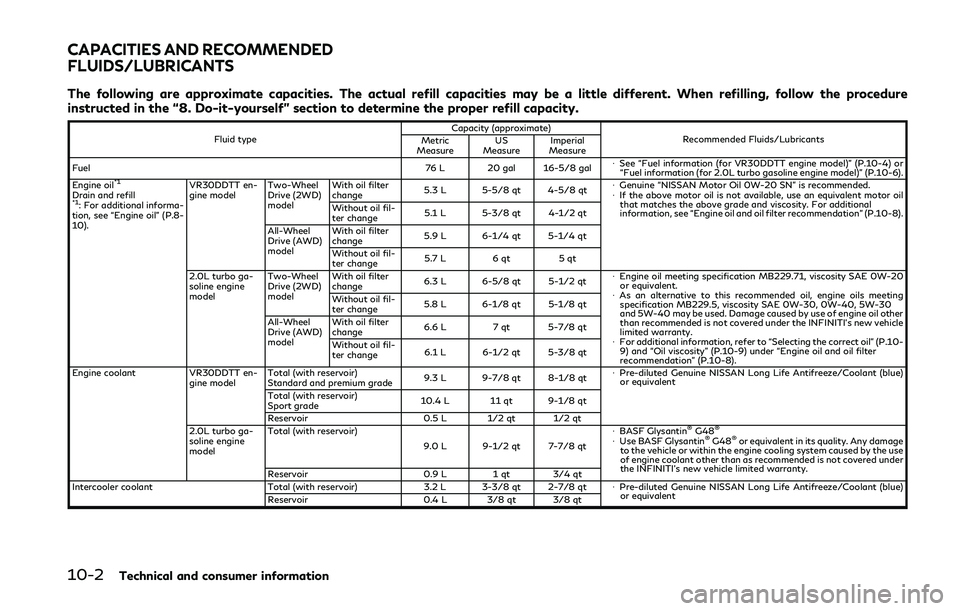
10-2Technical and consumer information
The following are approximate capacities. The actual refill capacities may be a little different. When refilling, follow the procedure
instructed in the “8. Do-it-yourself” section to determine the proper refill capacity.
Fluid typeCapacity (approximate)
Recommended Fluids/Lubricants
Metric
Measure US
Measure Imperial
Measure
Fuel 76 L 20 gal 16-5/8 gal�Â
See “Fuel information (for VR30DDTT engine model)” (P.10-4) or
“Fuel information (for 2.0L turbo gasoline engine model)” (P.10-6).
Engine oil
*1Drain and refill*1: For additional informa-
tion, see “Engine oil” (P.8-
10). VR30DDTT en-
gine model
Two-Wheel
Drive (2WD)
modelWith oil filter
change
5.3 L 5-5/8 qt 4-5/8 qt �Â
Genuine “NISSAN Motor Oil 0W-20 SN” is recommended.
� If the above motor oil is not available, use an equivalent motor oil
that matches the above grade and viscosity. For additional
information, see “Engine oil and oil filter recommendation” (P.10-8).
Without oil fil-
ter change
5.1 L 5-3/8 qt 4-1/2 qt
All-Wheel
Drive (AWD)
model With oil filter
change
5.9 L 6-1/4 qt 5-1/4 qt
Without oil fil-
ter change 5.7 L
6 qt5 qt
2.0L turbo ga-
soline engine
model Two-Wheel
Drive (2WD)
modelWith oil filter
change
6.3 L 6-5/8 qt 5-1/2 qt �Â
Engine oil meeting specification MB229.71, viscosity SAE 0W-20
or equivalent.
� As an alternative to this recommended oil, engine oils meeting
specification MB229.5, viscosity SAE 0W-30, 0W-40, 5W-30
and 5W-40 may be used. Damage caused by use of engine oil other
than recommended is not covered under the INFINITI’s new vehicle
limited warranty.
� For additional information, refer to “Selecting the correct oil” (P.10-
9) and “Oil viscosity” (P.10-9) under “Engine oil and oil filter
recommendation” (P.10-8).
Without oil fil-
ter change
5.8 L 6-1/8 qt 5-1/8 qt
All-Wheel
Drive (AWD)
model With oil filter
change
6.6 L
7 qt 5-7/8 qt
Without oil fil-
ter change 6.1 L 6-1/2 qt 5-3/8 qt
Engine coolant VR30DDTT en-
gine modelTotal (with reservoir)
Standard and premium grade
9.3 L 9-7/8 qt 8-1/8 qt �Â
Pre-diluted Genuine NISSAN Long Life Antifreeze/Coolant (blue)
or equivalent
Total (with reservoir)
Sport grade 10.4 L 11 qt 9-1/8 qt
Reservoir 0.5 L 1/2 qt 1/2 qt
2.0L turbo ga-
soline engine
model Total (with reservoir)
9.0 L 9-1/2 qt 7-7/8 qt �Â
BASF Glysantin
®G48®�ÂUse BASF Glysantin®G48®or equivalent in its quality. Any damage
to the vehicle or within the engine cooling system caused by the use
of engine coolant other than as recommended is not covered under
the INFINITI’s new vehicle limited warranty.
Reservoir 0.9 L 1 qt 3/4 qt
Intercooler coolant Total (with reservoir) 3.2 L 3-3/8 qt 2-7/8 qt �ÂPre-diluted Genuine NISSAN Long Life Antifreeze/Coolant (blue)
or equivalent
Reservoir 0.4 L 3/8 qt 3/8 qt
CAPACITIES AND RECOMMENDED
FLUIDS/LUBRICANTS
Page 432 of 468

10-8Technical and consumer information
that can be harmful to the fuel system and
engine.
Octane rating tips
Using unleaded gasoline with an octane
rating lower than recommended above can
cause persistent, heavy spark knock. (Spark
knock is a metallic rapping noise.) If severe,
this can lead to engine damage. If you
detect a persistent heavy spark knock even
when using gasoline of the stated octane
rating, or if you hear steady spark knock
while holding a steady speed on level roads,
it is recommended you have an INFINITI
retailer correct the condition. Failure to
correct the condition is misuse of the
vehicle, for which INFINITI is not respon-
sible.
Incorrect ignition timing will result in knock-
ing, after-run or overheating. This in turn
may cause excessive fuel consumption or
damage to the engine. If any of the above
symptoms are encountered, have your ve-
hicle checked. It is recommended you visit an
INFINITI retailer for servicing.
However, now and then you may notice
light spark knock for a short time while
accelerating or driving up hills. This is no
cause for concern, because you get the
greatest fuel benefit when there is light
spark knock for a short time under heavy
engine load.
JVT0342X
API certification mark
API service symbol
ENGINE OIL AND OIL FILTER
RECOMMENDATION
VR30DDTT engine model
Selecting the correct oil:
It is essential to choose the correct grade,
quality, and viscosity engine oil to ensure
satisfactory engine life and performance,
see “Capacities and recommended fluids/
lubricants” (P.10-2). INFINITI recommends
the use of an energy conserving oil in order
to improve fuel economy.Select only engine oils that meet the Amer-
ican Petroleum Institute (API) certification
or International Lubricant Standardization
and Approval Committee (ILSAC) certifica-
tion and SAE viscosity standard. These oils
have the API certification mark on the front
of the container. Oils which do not have the
specified quality label should not be used as
they could cause engine damage.
Oil additives:
INFINITI does not recommend the use of oil
additives. The use of an oil additive is not
necessary when the proper oil type is used
and maintenance intervals are followed.
Oil which may contain foreign matter or has
been previously used should not be used.
Page 433 of 468
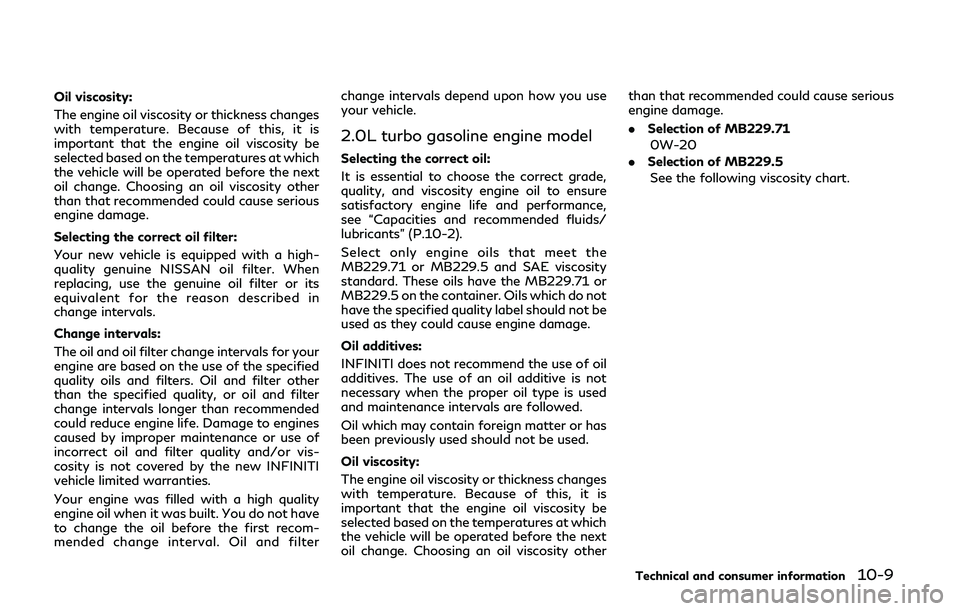
Oil viscosity:
The engine oil viscosity or thickness changes
with temperature. Because of this, it is
important that the engine oil viscosity be
selected based on the temperatures at which
the vehicle will be operated before the next
oil change. Choosing an oil viscosity other
than that recommended could cause serious
engine damage.
Selecting the correct oil filter:
Your new vehicle is equipped with a high-
quality genuine NISSAN oil filter. When
replacing, use the genuine oil filter or its
equivalent for the reason described in
change intervals.
Change intervals:
The oil and oil filter change intervals for your
engine are based on the use of the specified
quality oils and filters. Oil and filter other
than the specified quality, or oil and filter
change intervals longer than recommended
could reduce engine life. Damage to engines
caused by improper maintenance or use of
incorrect oil and filter quality and/or vis-
cosity is not covered by the new INFINITI
vehicle limited warranties.
Your engine was filled with a high quality
engine oil when it was built. You do not have
to change the oil before the first recom-
mended change interval. Oil and filterchange intervals depend upon how you use
your vehicle.
2.0L turbo gasoline engine model
Selecting the correct oil:
It is essential to choose the correct grade,
quality, and viscosity engine oil to ensure
satisfactory engine life and performance,
see “Capacities and recommended fluids/
lubricants” (P.10-2).
Select only engine oils that meet the
MB229.71 or MB229.5 and SAE viscosity
standard. These oils have the MB229.71 or
MB229.5 on the container. Oils which do not
have the specified quality label should not be
used as they could cause engine damage.
Oil additives:
INFINITI does not recommend the use of oil
additives. The use of an oil additive is not
necessary when the proper oil type is used
and maintenance intervals are followed.
Oil which may contain foreign matter or has
been previously used should not be used.
Oil viscosity:
The engine oil viscosity or thickness changes
with temperature. Because of this, it is
important that the engine oil viscosity be
selected based on the temperatures at which
the vehicle will be operated before the next
oil change. Choosing an oil viscosity otherthan that recommended could cause serious
engine damage.
.
Selection of MB229.71
0W-20
. Selection of MB229.5
See the following viscosity chart.
Technical and consumer information10-9
Page 435 of 468

ENGINE
ModelVR30DDTT2.0L turbo gasoline engine
Type Gasoline, 4-cycleGasoline, 4-cycle, DOHC
Cylinder arrangement 6-cylinder, V-slanted at 60° 4-cylinder, in-line
Bore × Stroke in (mm) 3.386× 3.386
(86.0 × 86.0)3.268 × 3.622
(83.0 × 92.0)
Displacement cu in (cm
3) 182.88 (2,997) 121.49 (1,991 )
Firing order 1-2-3-4-5-61-3-4-2
Idle speed rpm No adjustment is necessary.
Ignition timing
(B.T.D.C.) degree/rpm
Spark plug DILKAR8K8GSILZKFR8E7S
Spark plug gap
(Normal) in (mm)
0.031 (0.8) 0.028 (0.7)
Camshaft operation Timing chainTiming chain
This spark ignition system complies with the Canadian standard ICES-002.
STI0425
VR30DDTT engine
Technical and consumer information10-11
SPECIFICATIONS